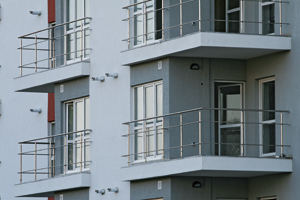Outside chance
Skyrocketing land prices outside of Bucharest are witnessing a correction, but fears arise that the city’s green suburbs are starting to resemble the towering urban landscape of the neighbouring capital
 |
|
|||||||||||||
During Communism Romania saw a consistent residential development with thousands of four to eight-storey apartment blocks delivered every year, as rural communities were forced into new urban environment to take up work in new factories.
These state-owned apartments were rented to young married couples who had to pay low monthly rents. The apartments were not for sale, but the tenants could keep them for as long as they wanted. In 1965 192,000 new housing units were constructed, and this building frenzy quickened its pace throughout the late 1960s and 1970s, with between 100,000 and 200,000 new units built annually, dropping to 80,000 per year during the end of the 1980s.
After the 1989 Revolution, virtually zero projects began for ten years. Meanwhile the nature of people’s vocations moved from a manufacturing towards a service economy and lifestyle tastes shifted. As residential development stalled, state bodies such as the National Housing Agency (ANL) developed only a few thousand units annually.
“This is why we have demand for one million homes all over Romania and 300,000 in Bucharest alone,” says Andrew Prelea, CEO of developers South Pacific.
Private enterprise has moved in to fill the gap in the market, which is now accelerating. In 2006 38,000 new homes were built and last year 46,000 were finished in Romania, which is still well below even the least zealous years of Communism.
The high prices of land in Bucharest – the densest capital city in central and eastern Europe – and rising construction costs have forced them to look to the outskirts to make a profit. Here the market should be in building a new suburbia.
In 2003 agricultural land plots in the capital’s suburbs in Ilfov county were put up for sale as locations for new living units. But demand for accommodation and overactive speculation has seen the land prices skyrocket.
Mert Berberoglu, managing partner at Turkish developer Plus Development, bought land in Pipera in Ilfov county for his company’s project, My Dream Residence, in 2005 for 100 Euro per sqm. Now the same land in the same area is trading for 1,000 Euro per sqm.
A land plot around Pipera and Voluntari, in a location with good infrastructure and the right to build high rise developments, can cost up to 1,200 Euro per sqm. However there are also areas without access to roads, water, sewerage, gas and electricity, where the land can be bought at around 40 Euro per sqm. Developers who decide to buy these lands at low prices and start to invest in building the infrastructure could still derive large profits in the long term, considering that the value of a property increases every year by at least ten per cent.
“A developer can pay between 1,000 and 1,200 Euro per sqm in Jandarmeriei in an area with high urban parameters that allows high rise developments up to nine floors,” says Radu Boitan, co-director, head of investments department at real estate agency King Sturge.
Prices steady
But land prices have not registered a significant increase compared to last year. While the average is stable, some prices are plummeting while others are registering a steady rise. Optimistic analysts argue this is because ‘quality areas’ have emerged.
“In northern Bucharest, in the city, the prices registered a slight increase compared to last year, which can be positive, as the market becomes more predictable and the risk measurement is easier to calculate,” says Alexandru Nitescu, projects & investment manager at real estate agency Regatta. “Lands outside Bucharest, in Ilfov and Dambovita, saw a slight price increase only in areas with intense real estate development.”
But some analysts paint a bleaker picture. Many speculators have bought up or sat on land in the suburbs of Bucharest ready to sell this on at a profit. Due to what many felt were over-valued land prices, last year saw a low number of transactions. But now some of these speculators are concerned that they may not make the gains they were expecting, especially as more risky investors are less enthusiastic to take a gamble in more austere times. The international credit crunch has also curbed the chances many speculators have of gaining credit for further land investment.
Until last year, banks were willing to finance up to 80 per cent of the transaction value of a land plot at a project stage. “Now the banks are significantly reducing this facility and are focusing more on granting financing to developers,” says Boitan.
Needing liquidity fast, many land speculators have become more flexible in their asking prices. In some instances this has triggered a 25 to 30 per cent drop in land prices. “This is a new trend for the domestic market, which has only witnessed ascending trends after 1989,” says Boitan.
Many analysts hope this is a natural correction, where the price of land begins to resemble its actual value. “Land prices have not gone down, but a realistic market has been achieved,” says Prelea. “What we are witnessing now is a market correction on unrealistic expectations.”
Some developers argue that the prices of “good land” doubled this year compared to 2007 and will continue to grow at a smaller pace than before. “Land plots which are dropping in value are those which were purchased purely for speculation and cannot be developed in the next two to three years due to a lack of infrastructure,” says Diwaker Singh, president & CEO of developer Copper Beech.
High hopes
Land prices in Ilfov may have wobbled, but they are still high. This has forced many developers to maximise the space on their plots, such as changing their plans from building villas and terraces to constructing high-rise apartment blocks, in order to make a profit.
Pipera, due north of Bucharest, was the setting five years ago for villas and houses. Now it is in a state of anarchy. Due to the reputation surrounding its exclusive location, prices of land have risen and developers have chosen to build high. Now it is populated by blocks of flats rising four to nine storeys. People who used to buy villas to escape the city and encounter large green areas now live in the shadow of the high-rises they worked all their life to leave. The suburbs are being urbanised, due to the lack of building regulations and the pressures that developers place on local authorities to build what they want where they want.
“The land is very expensive and we cannot afford to build houses, we have to use the land to the maximum height coefficient,” says Plus Development’s Mert Berberoglu. “We started developing My Dream Residence project two years ago and we thought about mixing houses with eight-floor blocks of flats. But eight floors are not enough and we could have gone higher.”
There are also projects including villas and blocks of flats no higher than four storeys, which can be integrated in the area. “We tried to build apartments similar to villas, no higher than four floors,” Federico Carapuig, marketing & sales manager of Spanish Ibiza House tells The Diplomat. “The land is so expensive now that it is almost impossible to build low rise developments. In Spain high buildings are concentrated in holiday resorts. In Madrid only the office sky-scrapers are very tall. But in Pipera you can even see buildings of 20 floors.”
The area now risks overpopulation. Some owners of villas, threatened by losing their privacy and attracted by the chance of making a good profit, have begun to sell their properties to developers who will demolish the dwellings and build massive apartment buildings in their place.
“This mix of villas and blocks of flats is abnormal, considering that the Iancu Nicolae neighbourhood in Pipera has developed for the past seven to eight years as a villa area,” says head of the residential department at real estate agency DTZ Echinox Mihaela Pana. “Many villa owners partner with their neighbours to have a large land plot which they can sell then to developers eager to build high.”
The owners are selling out the suburbs to the quick profits of high-rise living.
While developers claim they are only responding to the demands of the market and the profit incentive, the authorities readily release construction permits for the development of high-rises. Romanian cities have a General Urban Plan detailing the correct sizes of buildings and where constructions can happen, but this is regularly ignored.
“In Pipera-Voluntari, the first developers started building blocks of flats of four to five floors and the proximity of the [private English-language] American School and high demand attracted more developers in the areas,” says Ruxandra Cleciu, president of real estate agency Neocasa. “Voluntari City Hall probably thought that if the area is appropriate for villa developments, it is normal to issue construction permits for high rise blocks of flats.” The Diplomat tried to contact the mayor of Voluntari to discuss these issues, but no interview was forthcoming.
High buildings should be placed in areas offering spectacular views from the highest floors onto a lake, a park, mountains or a bright and sparkling night-time urban landscape. But Pipera does not offer any of these charms. If such a spectacle is not on offer, customers will always be attracted by apartments up to three floors in height, such as town houses from the 18th century – a home you can kick a ball over.
“Who wants to leave the city and live ten floors in the air?” asks Philip Stapely, CFO of Helios Development, which is building 710 apartments and villas in Clinceni, Ilfov county over a maximum of two floors. “In the next few years I don’t see these apartment projects with many levels being that successful. The reason is that you will not want to go and live so high in an area that you consider to be out of the city. Bucharest will expand so much in the future that those properties will be in the city or considered within the city. But this will happen in the long term.”
Some specialists consider the mix of villas and blocks of flats as not necessarily unsuccessful as long as the blocks are not higher than four floors. “I do not see anything wrong in the fact that the buyer of an apartment will be the neighbour of a one to two million Euro villa owner,” says Jacques Beer, CEO of Israeli Carmel Investments Group. “It will only reinforce the value of the area and will attract more apartment buyers.”
Many developers support the apartment-villa mix concept because apartments are cheaper and sell faster. “The selling ratio is of three apartments for one house,” says Andrew Prelea of South Pacific. Meanwhile houses generate an atmosphere of community. They also add an aspirational target for the apartment owners.
“If it works, don’t fix it - some of the lessons of the past can work for us today - for example Dorobanti’s pleasing mix of low rise purpose built apartments, modest attached houses and grandiose villas is a balanced concept that developers should use as a good example,” says Jeff Kirby, CEO European Future Group. “Bucharest has some beautiful neighbourhoods which create precedents for developments today. Domenii, Casin, Dorobanti and around Parcul Icoanei are all lovely neighborhoods that were originally really developments. Gracious architectural detailing, plenty of trees, meaningful green spaces and a pleasing mix of house sizes and types are what makes a good community.”
In the United States the anonymous suburbs of isolated houses built one after another outside of the major cities create car dependence and lack a sense of community or place - the other extreme of the crowded high rise blocks which were built in response to the post-war housing crisis create terrible public spaces, traffic jams, pollution and attract ‘ghettoisation’.
“It seems to me that it is the middle road which is the most appropriate, extreme conditions do not make good places to live,” says Kirby. “Lessons we can learn from the 19th Century, about clean air, small parks, a mix of house types and sizes, and quality public spaces are the direction that developers should be looking at today.”
Report by Corina Ilie
North rules
Despite infrastructure shortcomings, Pipera remains a top target for developers in Ilfov
The presence of private schools, the proximity to the mall Baneasa Shopping City and new office developments, as well as acceptable road, water and gas infrastructure are reasons for developers to build in Pipera.
The connection to the as-yet-unbuilt Bucharest-Brasov motorway east of Pipera is another positive aspect that points to the area’s potential. But although this may improve transport links, a large grey slab of vehicles speeding past a residential development is not the quiet life some householders are dreaming about. This project will also take many years to complete – which means the drawbacks of the construction stage will not be offset by the convenience of the transport links.
“There are 30,000 people working in this area at the moment and this number is going to be increased by another 25,000 people by the end of this year,” says South Pacific’s Andrew Prelea. “Generally people like to live close to work.”
South Pacific acquired a large plot in Pipera-Tunari in 2005 and started developing its complexes on an Australian model of suburban living. For this, the company invested in building four kilometres of road to connect Tunari to Pipera. Developers do not seem to be discouraged by the infrastructure shortcomings. Prelea says he is “confident” about future road developments linking up his project to the city, although he has no precise information about the plans of the Ilfov authorities. “This uncertain infrastructure cannot last for 100 years,” Ibiza House’s Federico Carapuig hopes.
Some developers believe the authorities alone should manage the road infrastructure issues and are not prepared to invest in building roads. “We can provide the electricity and gas, but we cannot provide the roads,” says Ahmet
Buyukhanli, chairman of the Buyukhanli Group, developers of the Cosmpolis project in Stefanestii de Jos. “We can only improve our complex and the community nearby, but if we are talking about motorway or other roads, these are government issues.” Over 5,000 units, both apartments and villas in 15 ongoing residential projects will be delivered in Pipera within the next three years.
Arc remains popular
Despite hopes for a renaissance in the south of Ilfov, areas in an arc around the north of the capital are considered locations with the highest development potential. These include Otopeni, Chitila, Ionescu-Sisesti, Snagov and Stefanestii de Jos.
“The north will probably remain the star area for a long time, because it is connected to the residential part of the city,” argues DTZ Echinox’s Mihaela Pana. “But developers have understood that to make a profit they need to find land plots in other areas. The retail market has concentrated in the south, so there are many opportunities for residential developments in that area.”
Andrew Prelea of South Pacific believes all the area between Stefanestii de Jos to Snagov will be very developed in the future, due to the ongoing development of Bucharest-Brasov motorway. “People will no longer mind commuting ten kilometres on a highway to go to work in the city,” he adds.
“Otopeni in north Bucharest, Corbeanca, Mogosoaia and Tartasesti, areas with good road infrastructure and utilities, are the most targeted at the moment,” says Alexandru Nitescu, projects & investment manager at real estate agency Regatta.
In the south, Popesti-Leordeni and Cernica are hot areas, but important residential projects have not been developed yet here. “It could be an option for affordable housing,” says Neocasa’s Ruxandra Cleciu.
Chitila, in north-west Bucharest, is the site of a massive new German-style complex development by Tiriac Holdings. In Chitila, Romanian company Triumf Construct is developing two residential projects with 28 apartments, while developer MB Dezvoltare will deliver this year 80 units. This area has the benefit of low-level and well-ordered streets. A metro is planned near the zone – but this has been delayed for many years. But this is not a major drawback, as it takes around 20 minutes by car to get to Piata Victoriei from Chitila at any hour of the day.
Speculation on a suburban ideal
Bucharest’s suburbs see a customer mix of investors and the new middle class
New apartments and villas outside Bucharest are still not affordable housing for most people, although they are cheaper than new blocks and antique houses erected in Bucharest’s city centre.
Prices for the outskirts now range between 1,200 Euro and 2,100 Euro per sqm. The buyers are usually middle and top management representatives, either foreigners or Romanians who own their own cars and can cope with the problems in road infrastructure and the lack of a metro.
My Dream Residence complex is developed on a 40,000 sqm land plot on Soseaua Pipera-Tunari and is set for completion this November. “Most of our customers are foreigners,” says its developer Mert Berberoglu. “In the beginning we sold mostly to customers from abroad, such as from the UK and Spain. So far we have sold around 65 per cent of the 183 apartments at prices ranging between 1,500 and 2,100 Euro per sqm.”
Meanwhile in English Village in Clinceni, Philip Stapely has seen customers including a large number of managers from international companies, middle-management lawyers and doctors buying villas and apartments with an Anglo-Saxon flavour.
Priced at a lower level, Romanian subsidiary Opus Land Development, part of the Turkish Buyukhanli Group, has sold all its 565 apartments and villas built in the first phase and half of its second phase of its Cosmopolis project. Prices for two-room apartments in the Stefanestii de Jos-based project start from 85,000 Euro per unit, while a two- room apartment in a semi-central area of Bucharest such as Blvd Ion Mihalache costs around 120,000 Euro. Developers of large scale projects, delivered in several stages, usually afford to sell the living units included in the first development stage, at lower prices.
“When the projects are larger, the prices per unit should definitely be lower because developers negotiate the construction material prices on cash-and-carry and can get discounts,” Neocasa’s Ruxandra Cleciu argues.
However many of these projects are not bought out by people who intend to live in apartments and villas. Foreign investors or investment funds are potential buyers, interested in acquiring living units in residential complexes to sell them on later at higher prices. While some of the developers do not care who the future owners will be as long as they get their money, others think that selling apartments which will be uninhabited for a long time is against the community spirit that they are trying to create. This creates a ghost block concept – where half the rooms in an apartment complex lay empty for months and years, waiting for the market to pick up.
“Unlike other competitors we have sold primarily to Romanians, not to foreigners,” argues Stapely. “We were originally advised to sell a large portion of the project to foreign investors. But because our development is based on a community concept we did not want to create an environment where nobody lives and the owners are all investors.”
So far Jacques Beer, president of Israeli developer Carmel Investments, has sold around 30 apartments of the 229 in the Green Vista residential complex in Pipera, ten of them were acquired by the Italian Cefin Group. “We prefer to have a mix of investment funds and end users,” says Beer. “We cannot avoid that people buy apartments for investment purposes.”
Prices for apartments and villas in Ilfov average at around 1,500 Euro per sqm depending on accessibility, finishings and facilities. “There are some buildings that are too high which reduces the degree of comfort and some others the construction of which low quality materials were used,” says Mihaela Pana. “In these cases the price is too high and unjustified.”
Reports by Corina Ilie
New town location
If developers commit to their time-plans, Ilfov county will see almost 1,500 new living units, including villas and apartments by the end of 2008.
But manpower shortages, financing difficulties and rising construction costs will help delay some of these targets.
In areas with several residential projects, the development with the shortest delivery term is most likely to attract the highest number of customers, considering the high housing demands.
As well as those detailed below, developers have also started to explore other villages around Bucharest. Balotesti, Saftica, Cernica, Afumati and Glina see a few projects at the moment.
Pipera was the first area outside Bucharest exploited by residential developers. Most of the projects due for this year in Ilfov are located here or on Soseaua Pipera Tunari. This includes Australian developer South Pacific, which has acquired a large land plot in Pipera-Tunari and announced the conclusion of works this year on two of its three projects. Sydney Residence with 102 villas was delivered last June, while Melbourne Residence with 71 units is expected for completion this month. The American School neighbourhood will witness this year the delivery of three new residential complexes. My Dream Residence, developed by Turkish Plus Development includes 183 apartments and is due for November 2008. Spanish company Ibiza House will finish 304 apartments this autumn. By December 2008 Liziera Residence, developed by Ferco Investments on an 18,000 sqm land plot and including 176 apartments should be ready.
In Corbeanca this December a private developer will finish works on six blocks of flats in an investment estimated at eight million Euro. Greek developer Crown Constructions began to build this year Apollonia Gardens in Corbeanca, including 58 villas, tennis courts and a mini-football ground. A.Panayides Contracting and Terra Capital have announced investments of around 60 million Euro in the development of 120 villas in Corbeanca. The largest project in Corbeanca with official data is Casa Nova Residence, developed by Asset Management System, with a total of 800 villas, 16 tennis courts and four swimming pools, set for delivery by 2013.
In Snagov a small two million Euro Japanese neighbourhood consisting of four villas with areas between 300 and 500 sqm is being built by Falcon Group. Romanian Evrika Haus has two ongoing villa projects in Snagov, called Reveria Snagov 1 and Reveria Snagov 2, with an unclear delivery date. This November Romanian company Snagov Limited will have 43 villas ready within Aleea cu Magnolii project.
Highly touted along with Chitila, Otopeni lies near to the International Henri Coanda Airport. The presence of the Bucharest-Otopeni motorway which travels to the mountains are major advantages offsetting the high level of noise and air pollution. Few projects will be delivered this year but four projects, two of which will be ready by 2009, are under development. Developer Primak Invest Europa will bring 154 new apartments to Otopeni, along with another 140 apartments delivered by Well Group. Around 72 more apartments will be available by May 2009 in the Otopeni Bridge project. MCR Invest is working at the moment on 100 villas in the Ansamblul Craitelor project.
With great connections to Bucharest centre and lying half-in and half-out of the city, Chitila has great development potential and is insufficiently exploited. Residenz, the German neighbourhood, developed by Tiriac Imobiliare and due for delivery by next July is the only significant project here. The complex includes 480 apartments and is developed in partnership with German LBBW Immobilien on a German design concept. This October MB Dezvoltare will deliver Lac de Nuferi apartments and villa complex with a total of 80 units. Romanian Triumf Construct has also started the development of two small apartment projects totaling 28 units.
In Stefanestii de Jos, the largest projects in Ilfov county are mixed-use compounds developed by Turkish Opus Land Development and Spanish Martinsa Fadesa. While Cosmopolis offers 4,600 villas and apartments, commercial, office and sports spaces to be delivered in seven phases by 2014, the delivery of Bonnaire Community with 7,600 apartments will be prolonged until 2015.
Famed for its film studios, Buftea is growing in the attention of developers. Real estate company European Future Group is preparing the delivery in two stages by 2011 of Buftea Village with 900 units. The completion of a ten villa project called Lake Village Residence, situated on Zmeu Lake has also been announced for this year, while Israeli developer Barak International intends to build the fashionably-named Barak Residence complex with 300 dwellings, shopping units and swimming pool for 2011.

















